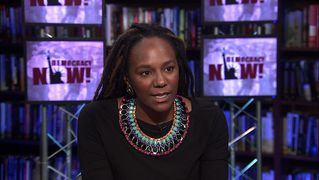
By Amy Goodman and Denis Moynihan
“What, to the American slave, is your 4th of July?” asked Frederick Douglass of the crowd gathered at Corinthian Hall in Rochester, N.Y., on July 5, 1852. “I answer,” he continued, “a day that reveals to him, more than all other days in the year, the gross injustice and cruelty to which lie is the constant victim. To him, your celebration is a sham.”
Douglass escaped slavery in 1838 and became one of the most powerful and eloquent orators of the abolitionist movement. His Independence Day talk was organized by the Rochester Ladies’ Anti-Slavery Sewing Society. Douglass extolled the virtues of the Founding Fathers, those who signed the Declaration of Independence. Then he brought the focus to the present, to 1852. He said:
“I am not included within the pale of this glorious anniversary! Your high independence only reveals the immeasurable distance between us. The blessings in which you, this day, rejoice, are not enjoyed in common. The rich inheritance of justice, liberty, prosperity and independence, bequeathed by your fathers, is shared by you, not by me. The sunlight that brought life and healing to you, has brought stripes and death to me. This Fourth July is yours, not mine. You may rejoice, I must mourn. To drag a man in fetters into the grand illuminated temple of liberty, and call upon him to join you in joyous anthems, were inhuman mockery and sacrilegious irony. Do you mean, citizens, to mock me, by asking me to speak today?”
Of course, the Rochester Ladies’ Anti-Slavery Sewing Society had no intention of mocking him. Proceeds from their events were devoted primarily to supporting Douglass’ newspaper. They championed Douglass, and saw the need to take action, whatever action they could muster. The United States was, at the time of the speech, less than a decade away from a brutal civil war. The war would formally start with the Confederate bombardment of Fort Sumter, just off the coast of Charleston, S.C.
Independence Day is a fitting time to reflect on the role that grass-roots organizing for social change has played in building this nation. The horrific massacre at the Emanuel African Methodist Episcopal (AME) Church in Charleston, S.C., also compels us to question just how far we have progressed toward the ideals enshrined in that document signed on July 4, 1776, the Declaration of Independence.
It was in Charleston that a man named Denmark Vesey, a former slave who had won his freedom, had planned an expansive slave rebellion, slated to take place in 1822. The plot was exposed, and Vesey, along with 34 alleged co-conspirators, was hanged. Vesey was one of the founders of Charleston’s AME church in 1818, which became Emanuel AME Church, where Dylann Roof is alleged to have murdered nine people this past June 17, among them the church’s pastor, who was also a state senator, the Rev. Clementa Pinckney. The storied church, called “Mother Emanuel,” has been central to the lives of African-Americans in Charleston and beyond for close to two centuries.
So, when evidence pointing to Roof’s racist motivation surfaced, including an Internet-posted manifesto along with numerous photos of him with the Confederate flag, pressure mounted to remove that flag from the grounds of the South Carolina state Capitol in Columbia, S.C. The movement was swift, with companies like Wal-Mart and Amazon pulling Confederate memorabilia from their shelves. Alabama Gov. Robert Bentley immediately ordered all Confederate flags be removed from Alabama Statehouse grounds. But as the U.S. and South Carolina flags on the Capitol Dome flew at half-mast after the massacre, the Battle Flag of the Confederacy, at a Confederate war memorial on the Statehouse grounds, continued to fly at full mast.
On Friday, June 26, more than 5,000 mourners crowded into an arena in Charleston for the funeral of the Rev. Pinckney. President Barack Obama gave a moving eulogy, ending by singing “Amazing Grace” as the congregation joined in. The next day, at dawn, Bree Newsome, a 30-year-old African-American woman, scaled that 30-foot flagpole in Columbia with helmet and climbing gear, and took down the Confederate flag. James Tyson, a fellow activist who is white, spotted for her from the base of the pole.












Media Options